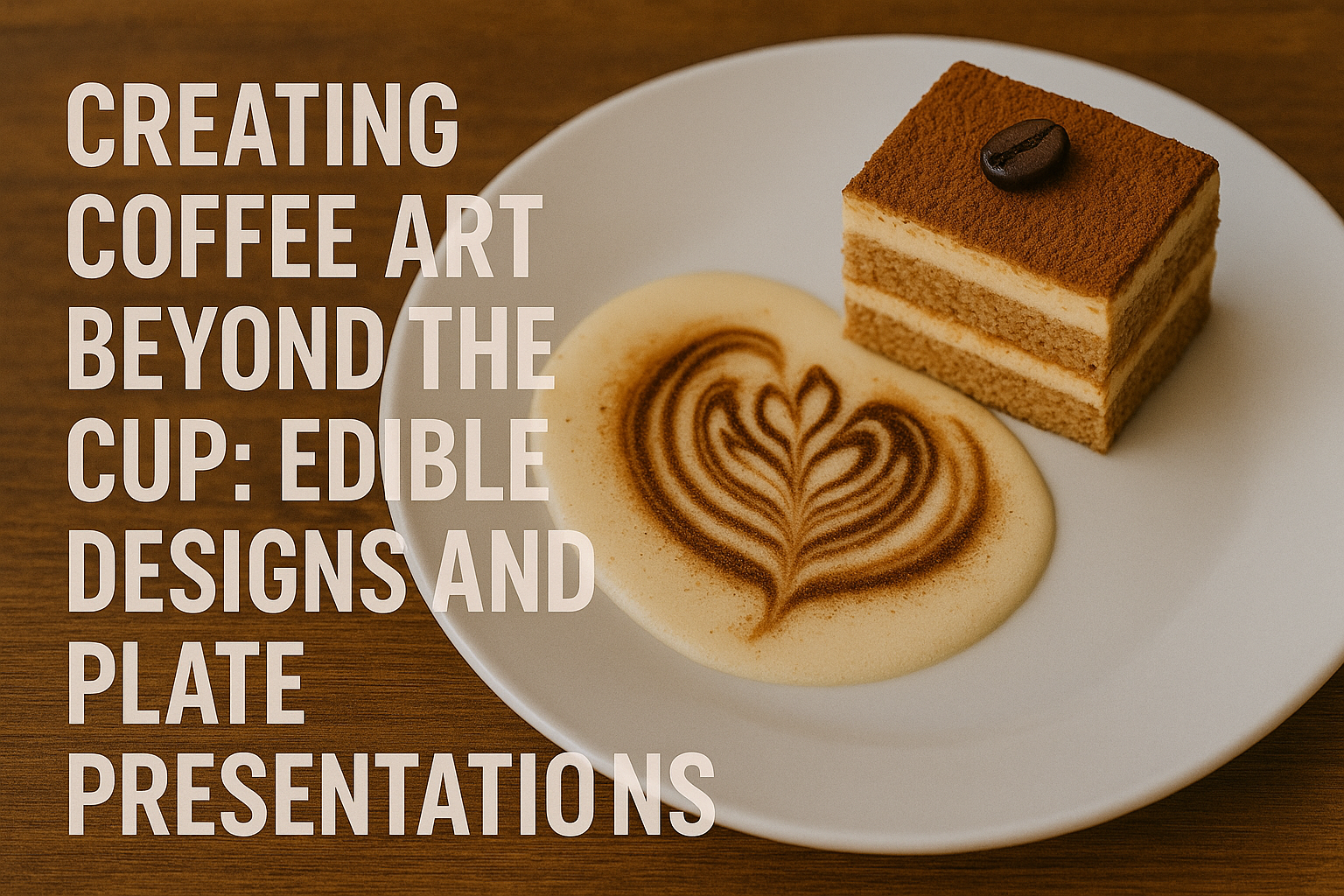In the world of specialty coffee, latte art has long been the visual signature of a skilled barista.
But as customer expectations evolve and cafés explore new ways to deliver a memorable experience, latte art is expanding — literally — beyond the cup.
From edible decorations to intricately designed plate presentations, the lines between barista work and culinary artistry are blurring. Coffee is no longer just served; it’s staged, styled, and curated to engage every sense.
In this article, we’ll dive into the rise of edible coffee art, how it enhances customer experience, the tools and techniques involved, and how cafés are using this form of creative expression to stand out in a crowded market.
The Shift From Simple Presentation to Culinary Theater
In the early 2000s, pouring a heart on top of a cappuccino was a rare and delightful experience. Today, it’s expected.
With the rise of Instagram, TikTok, and foodie culture, visual presentation is no longer just a finishing touch — it’s part of the product itself.
Cafés are now designing entire presentations around the drink. From saucers with edible flowers to desserts crafted to pair visually and flavorfully with specific coffees, we’re witnessing a new era of “coffee plating.”
This movement aligns with broader hospitality trends where visual storytelling and immersive experiences define brand identity and customer loyalty.
What Is Edible Coffee Art?
Edible coffee art goes beyond milk foam designs and includes any decorative, consumable element that enhances the appearance of a coffee beverage or its presentation.
Examples include:
- Edible glitter or gold flakes on lattes
- Chocolate dust stencils on flat whites
- Latte toppers: custom printed edible images placed over foam
- Marshmallow or sugar-based foam art sculptures
- Dessert pairings styled to complement the coffee’s flavor and look
- Painted sauces and powders on serving plates
This approach bridges the gap between the barista and the pastry chef, creating collaborative, multi-sensory experiences.
The Psychology of Edible Presentation
When customers see that a drink has been thoughtfully and artistically presented, they assign higher value to it.
Studies show that the visual appeal of food affects its perceived taste. When paired with edible art or plated beautifully, customers are more likely to:
- Rate the drink higher
- Take and share photos online
- Return to the café for future experiences
Edible designs also stimulate curiosity and emotion. The moment of surprise — “Wow, is that glitter?” or “This looks too pretty to drink!” — strengthens memory and emotional connection.
This emotional impact builds brand loyalty and word-of-mouth promotion, both powerful tools in the hospitality industry.
Tools of the Trade: What You Need to Create Edible Coffee Art
To master this style of presentation, cafés need more than a steady hand and good milk foam. Here’s a look at some essential tools and ingredients:
1. Edible Inks and Printers
Used to create custom toppers with logos, photos, or designs. These sheets are placed directly on the foam and dissolve without altering flavor.
2. Stencils and Dusts
Reusable stencils allow for fast, consistent application of designs using cocoa powder, cinnamon, or matcha.
3. Brushes and Culinary Paints
Pastry brushes and edible paints let baristas (or pastry chefs) create hand-painted accents on saucers or serving plates.
4. Silicone Molds
Used to shape chocolate, sugar, or foam into themed accents (e.g., hearts, stars, coffee beans).
5. Precision Tongs and Tweezers
For placing edible flowers, flakes, or other fragile elements delicately onto the coffee or plate.
6. Digital Thermometers and Timers
Consistency matters — both visually and texturally. Accurate timing and temperature ensure milk texture holds shape for art and foam stability.
Designing the Full Coffee Plate Experience
Much like a chef plates a dish, cafés are starting to plate coffee drinks. The idea is to use the plate as a canvas — not just a coaster.
Visual Flow
The elements on the plate should guide the eye naturally. If pairing with a dessert, ensure it doesn’t overpower the coffee but rather complements it in color, shape, and texture.
Edible Accents
Use small, edible garnishes that echo notes in the coffee: citrus zest, chocolate curls, spices, or edible flowers. These should not just look pretty but add subtle flavor enhancements.
Negative Space
Like in fine dining, less is often more. Clean, minimalist presentation allows each element — including the latte art — to stand out.
Matching Cups and Serveware
Color and shape matter. Neutral ceramics highlight milk contrast, while dark matte cups create a high-end look. Using locally crafted or custom pieces adds personality and storytelling to the experience.
Signature Plates: Building a Café Identity
Some cafés now create signature plate presentations that match the personality of the brand or region.
Examples:
- A tropical-themed café may plate an iced coffee with coconut flakes, banana leaf, and tropical fruit coulis.
- A minimalist Nordic-style café may serve espresso with chocolate bark and lingonberry powder.
By aligning visual identity with flavor and environment, cafés turn each cup into a narrative — one customers remember and talk about.
Edible Art Meets Technology
Some cafés have begun to integrate augmented reality (AR) into their edible presentations. A QR code printed on a cookie leads to a short video of the farm where the coffee was sourced. Or latte foam that dissolves to reveal a quote, visual, or message.
Other innovations include 3D latte printers, which can “draw” intricate designs on foam with edible ink in seconds.
This marriage of culinary art and digital storytelling is captivating the next generation of coffee lovers.
Team Collaboration: Baristas and Pastry Chefs
Creating edible presentations often requires coordination between different parts of the café.
Baristas must understand plating, and pastry chefs must understand espresso timing. Successful execution demands communication, shared vision, and synchronized service.
Some cafés host internal competitions to encourage creative drink + dessert pairings, which are later featured as weekly specials.
Training and Consistency
While creativity is key, consistency is what keeps customers coming back.
Training your team to replicate edible presentations with precision is vital. This may include:
- Standard operating procedures (SOPs)
- Visual reference sheets
- Workshop sessions on plating and latte art
- Quality control checklists
Consistency ensures that even the most beautiful creation maintains the same high standards day after day.
Marketing Benefits of Edible Coffee Art
Edible coffee art is inherently Instagrammable. This makes it a marketing powerhouse.
Customers post what they love. When your drinks look like art, they become free advertising — generating awareness and attracting visually driven audiences.
Promotions, such as “Latte Art Saturdays” or “Dessert Pairing Week,” can further boost interest. Limited-edition designs or collabs with local artists also generate hype.
In-store signage that explains the story behind a design — or the ingredients — increases appreciation and engagement.
Sustainability and Edible Decorations
As edible art grows, sustainability remains a priority. Here are tips for keeping your designs green:
- Use locally sourced garnishes (herbs, citrus peels, edible flowers)
- Avoid plastic embellishments or unnecessary single-use tools
- Repurpose dessert trimmings for plate decoration
- Compost any organic waste from food styling prep
Being sustainable doesn’t mean compromising on creativity — in fact, it often sparks more thoughtful design.
Challenges to Consider
While edible coffee art is exciting, it comes with challenges:
- Time-Intensive: Some designs slow down service during peak hours.
- Training Curve: Staff need time to master techniques.
- Ingredient Management: Keeping perishable garnishes fresh requires planning.
- Customer Expectations: Once you raise the visual bar, customers expect it every time.
Balancing art and speed is the key to integrating this style successfully into daily operations.

Artur is a coffee enthusiast and content creator passionate about barista techniques and coffee culture. With a sharp eye for detail and a love for learning, he shares practical tips, brewing guides, and gear insights to help readers elevate their coffee experience — from home brewers to aspiring professionals.
